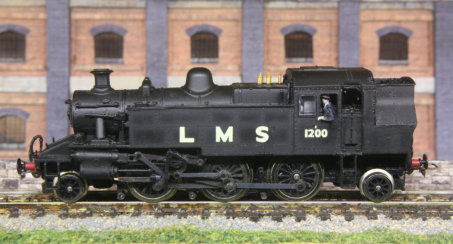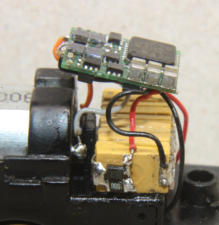
Locomotives
All locos are fitted with DCC decoders, with control
being the free open-source software JMRI DeCoder-
Pro with a SPROG 3 module providing interface to
the track. Mobile phone and an Android tablet
running the free software Engine Driver, being used
as throttles with Wi-Fi connection to DeCoder Pro.
I have also fitted a DIY Stay-Alive circuit to the
decoders. Commercial modules are available, but
these tend to be far too large for N-Gauge steam
locos, and cost as much as the more expensive
decoders. These commercial modules use high value
Super-Caps and can keep a loco running for several
seconds over isolated sections of track.
In practise all that is really required is to keep the
decoder and loco alive over short dead areas at
points or small sections of dirty track, especially with
short wheel base shunting locos, where it is all too
easy for some wheels to lose contact with the track if
the loco rocks at all as it crosses a point.
There are several designs of DIY Stay-Alive modules
which have been published on the Internet. I have
used a version of these using surface mount 220uF
Tantalum Capacitors which are rated at 16v DC,
several being wired in parallel, together with a surface
mount 100R charge limiting resistor and a surface mount bi-
pass diode.
A very informative article on DIY Stay-Alive is by Nigel
Cliffe.
Some decoders e.g. the Lenze Gold and ESU LokPilot V4,
have convenient pads to which you can solder the added
circuit, other decoders require much more delicate soldering
to connect to the internal DC voltage of the decoder. Note
this connection is not the track connection. You do need a
very fine solder tip on a good temperature controller iron -
so only attempt this if you have suitable experience - the
decoder warranty may well be voided if you get it wrong !
Depending on how many capacitors you can fit, usually
these have to go into the cab, with modern coreless motors
you get about a quarter to half a second of running over
dead track; OK - nothing like the commercial Stay-Alive
modules, but enough to make a worthwhile difference.
Once the capacitors are painted with matt black and suitably
placed crew added then they are not at all obvious.
I have not had the courage yet to try weathering the locos,
so they are all in ex-works condition - for now!



The Ivatt 2-6-2 tank loco is by Dapol. It was quite
a good runner but did hesitate on some of my
points on Archie’s Yard, particularly on the double
slip, and often needed a poke to get it going from
rest.
I managed to fit five capacitors onto the floor of
the cab with a Lenz Gold Mini decoder tucked into
the roof. This loco now runs like a dream - no
hesitation at creep speeds and starts straight
away. I did also add 5 grm of lead into the top of
the boiler space (the capacitors also added a
useful 3 grms) increasing the total weight from
44grms to 52grms.
This loco pulls eight coaches plus a couple of
wagons with additional load of 75 grams up a 3%
slope; with only slight wheel slip if you accelerate
it hard.
The standard big-lump-of-plastic couplings have been
replaced with DG couplings, with hook, latch and loop. This
allows uncoupling by pushing slowly over small cylindrical
rare-earth magnets, hidden beneath the sleepers. The latch
enables you to keep pushing the wagon till it is at the required
point, and then to pull away leaving the wagon in place.
Pulling wagons over the magnets does not uncouple them.


These photos show the capacitors and decoder in the
cab area of the loco. I did need to fettle the inside of
the body moulding a little bit to get the circuit to fit.
You can see the resistor & bi-pass diode on the left
hand photo. Ideally I should have used wire colours
other than red/black for the extra circuit.
Once the capacitors are painted matt black and train
crew are added then they are not at all obvious.


This is fitted with an ESU Lokpilot micro V4 encoder, and a
stay-alive circuit with six 220uF capacitors in the cab area.
It pulls eight coaches up a 3% slope, with some wheel slip.
The wheel slip was cured by replacing the standard “coal
load” with one made from lead, gave enough additional
traction as the driving motor is is the tender.
The creep speed is excellent - 8 minutes to travel a metre,
with no hesitation on points.

Photos to follow.
This is actually an early BR shunter, but the LMS did experiment
with this type just prior to nationalisation. Strictly I should re-
badge and renumber this loco to fit the period of the layout -
even so I don’t think any were used in the Yorkshire Dales area.
But it is superb in operation; fitted with an ESU Lokpilot micro
V4 decoder and a stay-alive circuit, it will crawl at 8 minutes to
travel a metre, with no hesitation. The model is quite a
reasonable weight, so pulls a long train of wagons up a 3%
slope, no problem. On a test it hauled 8 coaches plus 2 wagons
with extra load 75 grams up the 3% slope on the layout.
On my test rig it hauled 4 wagons loaded with a total of 151
grams up a 3% slope.
At 5% slope it managed 95 grams in 3 wagons.

Photos to follow.

This is a excellent model with detailed cab area. Electrical pickups
are on all loco and tender wheels, so it runs well on the flat.
However the motor is in the loco and because of the design of the
boiler in this class there is little room for any added weight. It
managed to pull 2 wagons with 40 grams of added load up the 3%
slope on the layout, but could not manage 75 grams due to wheel
slippage because of lack of traction with the rails - the motor is
powerful enough.
Being disappointed with its lack of traction I did some research and
decided to try a jar of Bullfrog Snot ( see www.bullfrogsnot.com ),
although American it is available in the UK. This is a green goo that
you apply to drive wheels, which cures overnight to a nearly
invisible traction tyre. It needs a bit of water adding to get the
right degree of fluidity for N-Gauge wheels.
Applying the goo to the four rear wheels of the loco and trying it
on my test rig, the loco now manages 179 grams in 5 wagons on
the 3% slope and 116 grams in 3 wagons on the 5% slope. A very
impressive boost to performance. The only down side is some loss
of electrical contact due to 4 wheels on the loco now being
effectively insulated from the track, but there was plenty of room
in the tender for eight 220uF stay-alive capacitors, so the loss of
wheel contact has not proved to be a problem.

Photos to follow.



























